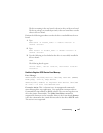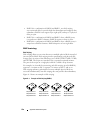
Appendix: RAID Description 131
Disk Mirroring
With mirroring (used in RAID 1), data written to one disk is simultaneously
written to another disk. If one disk fails, the contents of the other disk can
be used to run the system and rebuild the failed physical disk. The primary
advantage of disk mirroring is that it provides complete data redundancy.
Both disks contain the same data at all times. Either of the physical disks can
act as the operational physical disk.
Disk mirroring provides complete redundancy, but is an expensive option
because each physical disk in the system must be duplicated.
NOTE: Mirrored physical disks improve read performance by read load balance.
Figure A-2 shows an example of disk mirroring.
Figure A-2. Example of Disk Mirroring (RAID 1)
Spanned RAID Levels
Spanning is a term used to describe the way in which RAID levels 10, 50,
and 60 are constructed from multiple sets of basic, or simple RAID levels.
For example, a RAID 10 has multiple sets of RAID 1 arrays where each RAID 1
set is considered a span. Data is then striped (RAID 0) across the RAID 1
spans to create a RAID 10 virtual disk. Similarly, RAID 50 and RAID 60
combine multiple sets of RAID 5 or RAID 6 respectively with striping.
Parity Data
Parity data is redundant data that is generated to provide fault tolerance
within certain RAID levels. In the event of a disk failure the parity data can be
used by the controller to regenerate user data. Parity data is present for RAID
5, 6, 50, and 60.
Stripe element 1
Stripe element 2
Stripe element 3
Stripe element 1 Duplicated
Stripe element 2 Duplicated
Stripe element 3 Duplicated
Stripe element 4 Stripe element 4 Duplicated


















